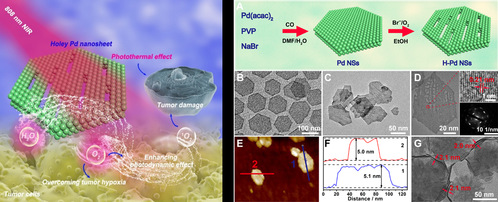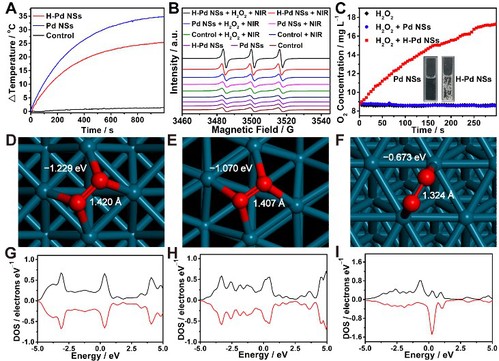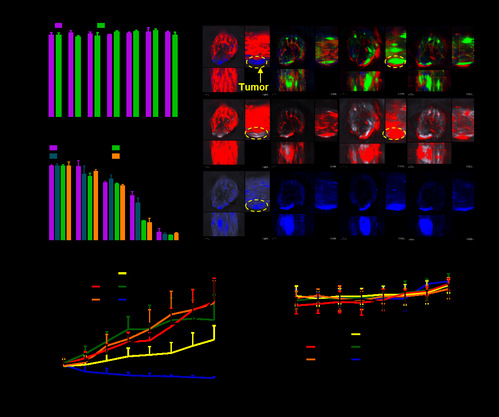Recently, holey palladium sheet (H-Pd NSs) with photodynamic, hydrogen peroxide catalytic decomposition ability and degradability have been developed by the team of Prof. Huiyu Liu from Life Science and Technology of Beijing University of Chemical Technology, and Dr. Zhijun Huang from the Institute of Chemistry of the Chinese Academy of Sciences. The H-Pd NSs can achieve photothermal / photodynamic synergistic therapy of tumors under the excitation of near-infrared (NIR) light. In addition, due to the construction of one-dimensional pore structure, H-Pd NSs can also efficiently catalyze the decomposition of hydrogen peroxide to generate a large amount of oxygen, thus overcoming tumor hypoxia and enhancing the photodynamic therapy effect. Also,H-Pd NSs can rapidly degrade in physiological media.This work revealed the relationship between the active crystal plane and the photodynamic performance, and provided a reference for the design and construction of multifunctional single-component metal-based nano-diagnostics. This work was published in J. Am. Chem. Soc. (DOI: 10.1021/jacs.9b12929). The first authors of this paper are Shanshan Li, Kai Gu from Beijing University of Chemical Technology and Ph.D. Hui Wang from the National Nanometer Center. Professor Huiyu Liu and Dr. Zhijun Huang are the corresponding authors. Researchers of Xinghua Shi's team from National Nano Center provided technical assistance in theoretical calculations.
Bifunctional phototherapy agents, which simultaneously possess the intrinsic photothermal and photodynamic functions, have shown promise for application in cancer therapy due to their much higher efficacy than single-modal photothermal therapy (PTT) or photodynamic therapy (PDT) agents. However, the PDT effect of these bifunctional PTT/PDT agents is highly dependent on the O2 supply. Tumor hypoxia, one of the principal features of solid tumors, significantly limits the therapeutic efficiency of PDT. Moreover, continuous O2 consumption and vasculature injury during PDT might further accelerate tumor hypoxia and reduce the PDT effect in turn. In addition, most of the Bifunctional phototherapy agents reported show complicated structures and complicated synthesis progress. Therefore, it is critical to develop nanomaterials with inherent structural multifunctionality for regulating tumor hypoxia and improving therapeutic efficacy in cancer phototherapy. To this end, Prof. Huiyu Liu's team prepared holey Pd NSs (H-Pd NSs) with highly active Pd(100) facets on the walls of one-dimensional (1D) holes by anisotropic oxidative etching of intact Pd NSs, which show inherent biodegradable ability and photodynamic property. H-Pd NSs have the following characteristics: 1) It shows high photothermal efficiency under the trigger of NIR light; 2) Highly active Pd(100) facets on the walls of one-dimensional (1D) holes endow H-Pd NSs with high efficiency for the decomposition of H2O2 to O2 and the activation of O2 to reactive oxide species (ROS) under NIR light irradiation, which makes it great candidate for PDT against hypoxic tumors; 3) The in vivo degradation behavior of H-Pd NSs is beneficial to its future clinical transformation.

Figure 1. TOC and characterizations of H-Pd NSs.

Figure 2.Photothermal, photodynamic, and catalytic properties of H-Pd NSs and Pd NSs.
Key points: Compared with Pd NSs (30.9%), H-Pd NSs show higher photothermal conversion efficiency (35.1%). Under the excitation of NIR light, H-Pd NSs can efficiently sensitize oxygen to generate singlet oxygen, and its ability to catalyze the decomposition of hydrogen peroxide into oxygen further enhances its photodynamic effect. Its photodynamic performance is related to the exposure of active Pd (100) crystal plane.

Figure 3.In vitro and in vivo therapeutic effect of H-Pd NSs.
Key points: H-Pd NSs can be efficiently internalized by 4T1 cells and show relatively good biological safety. Effective PTT / PDT synergy therapy is achieved both in vitro and in vivo under NIR light irradiation.
Huiyu Liu is full Professor at BUCT, awardee of the National Science Fund for Excellent Young Scholars. She received Ph.D. from the Technical Institute of Physics and Chemistry (TIPC), the Chinese Academy of Sciences (CAS) in 2007. From 2007 to 2010, she worked as an associate professor at TIPC. Prof. Liu joined the institute of College of Life Science and Technology at BUCT at the end of 2015. Her research mainly focuses on nanomedicine and nanobiology, including the safe design of **art nanoparticle-based platform for cancer therapy and the characterization and understanding of the biological effects of nanomaterials, with important implications in human health. Hosted 5 National Natural Science Funds
Her main achievements were published in well-known journals, including Angew. Chem. Int. Edit., Adv. Mater., Adv. Funct. Mater., ACS Nano and so on. So far, Prof. Liu published more than 80 papers which has already been cited more than 4800 times (H-index 33, Google Scholar statistics), including 43 first/corresponding authorship papers. Among them, 22 first/corresponding authorship papers have been published in A+ Journals with impact factor exceeding 10. Furthermore, 10 patents have been granted.
Paper link: http://dx.doi.org/10.1021/jacs.9b12929
Group website of Huiyu Liu: http://www.liuhuiyugroup.com
